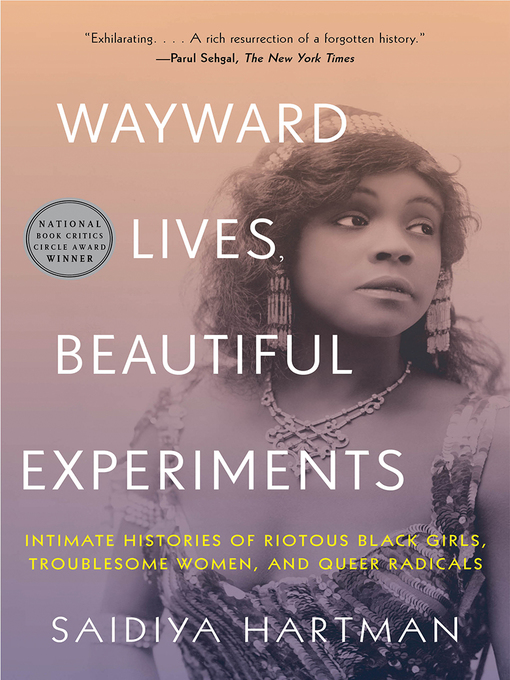
Wayward Lives, Beautiful Experiments
Intimate Histories of Riotous Black Girls, Troublesome Women, and Queer Radicals
- اطلاعات
- نقد و بررسی
- دیدگاه کاربران
نقد و بررسی

February 1, 2019
As black women streamed into cities at the turn of the 20th century looking for better lives, they struggled to push back at a system that forced them into domestic work, sexual violence, and police brutality. Hartman (English & comparative literature, Columbia Univ.;$SPACE$Lose Your Mother) scoured police and court records, as well as files and photographs of social workers and sociologists such as W.E.B. DuBois and Mary White Ovington, to tell these women's stories. These accounts primarily take place in Harlem, NY, and Philadelphia, as Hartman seeks to rewrite them from the women's perspectives. While Hartman veers into speculation about their inner lives (including paragraphs of unanswered questions), and her nonlinear chapter organization is difficult to follow, the book shines in its details of individuals including Mattie Jackson, Mamie Shepherd, Esther Brown, Eva Perkins, and Mabel Hampton, who fought against an unfair and racist system. As they sought freedom for themselves as performers or in relationships with other women, Hartman argues that they should be deemed revolutionaries. VERDICT Recommended for readers of black women's history who don't mind when the author meanders into conjecture.--Kate Stewart, Arizona Historical Soc., Tuscon
Copyright 2019 Library Journal, LLC Used with permission.

February 1, 2019
A provocative study of urban African-American women a century and more ago.Characterizing her work as an "account of the wayward," literary scholar Hartman (English/Columbia Univ.; Lose Your Mother: A Journey Along the Atlantic Slave Route, 2007, etc.) examines the many ways in which (mostly) young black women tried to live their lives within the confines of new urban enclaves such as Harlem and West Philadelphia, from which Italian and Jewish immigrants had moved on and into which newcomers from the South were streaming. The population, writes the author, was young and in many cases disproportionately female, with liberating follow-on consequences. In one Philadelphia area, for instance, "more than half the women in the ward were single, widowed, or separated, and this imperiled the newly fledged black family"--imperiled it because so many of those unencumbered women were determined to live on their own terms, having begun a journey to freedom that was ongoing. They faced formidable resistance within their own communities even as they willingly took on new roles: "In bed," Hartman writes of one lesbian couple, "it seemed like it was only the two of them in the world, in the vast stillness of the deep of night. In the few hours before dusk, there were no husbands to fear." The author populates her pages with reformatory inmates, reformers, sex workers, and political activists such as Harlem Renaissance figure Claude McKay, "known less well for his indiscretions than for the ease and facility with which he cloaked them." Sometimes Hartman's rhetoric becomes a touch too high-flown, as if swept up in the exuberance of the fight for freedom, and interrogatives sometimes threaten to overwhelm declarative sentences. However, close attention to "beautiful experiments" and "the sexual geography of the black belt," as two section titles have it, yield new insight into the truth of a central proposition: "No modern intelligent person was content merely existing. Sometimes it was good to take a chance."Lucid and original--of considerable interest to students of the African-American diaspora and American social and cultural history.
COPYRIGHT(2019) Kirkus Reviews, ALL RIGHTS RESERVED.

Starred review from February 25, 2019
In this lyrical and novelistic speculative history, Hartman (Lose Your Mother), a Columbia University professor of English and comparative literature, reconstructs the lives of unknown black female urban rebels from the early 20th century, everyday women whose existences are hinted at by court records, social workers’ notes, and photographs and who she heralds as “radical thinkers who tirelessly imagined other ways to live.” The photos (taken between 1890 and 1935) inspired the book, and each chapter is anchored by one, around which is woven a vignette about the inner experience of the woman depicted, sometimes zooming out to encompass whole parties or streets or neighborhoods, sometimes intersecting with historical figures of note such as sociologist W.E.B. DuBois, suffragist and NAACP cofounder Mary White Ovington, or actress Edna Thomas. Hartman wonders about and imagines her subjects’ lives between the archival lines in vivid detail. Taken together, the affectionate and reverent reconstructions add up to a picture of black urban women’s courage, their attempts to carve out freedom, love, autonomy, power, and pleasure in socially constrained circumstances: “A whole world is jammed into one short block crowded with black folks shut out from almost every opportunity the city affords, but still intoxicated with freedom.” This passionate, poetic retrieval of women from the footnotes of history is a superb literary achievement.

February 1, 2019
In the early decades of the twentieth century, thousands of young Black women were living in New York, Philadelphia, and other northern cities after fleeing servitude and sharecropping for the elusive dreams of freedom and opportunity. Though they were often subjected to exploitation, violence, and unsanitary living conditions, Guggenheim fellow and Columbia professor Hartman sees them as social revolutionaries, demanding the romantic and sexual liberty to socialize, dance, and shake off the restrictions of both white racism and Black respectability politics. Illustrated with startling historical photographs, Hartman's blend of narrative and imagined internal monologue uncovers a world of unjust imprisonment, child prostitution, and race riots but also lively dance halls and chorus lines and the daring transformation of tenement hallways into places of assembly and rooftops into stretches of urban beach. Although all of civil society condemned them as disreputable, these pioneering young women realized that the offense most punished . . . was trying to live free. Hartman has created an insightful feminist reassessment of a key era in American history.(Reprinted with permission of Booklist, copyright 2019, American Library Association.)




دیدگاه کاربران